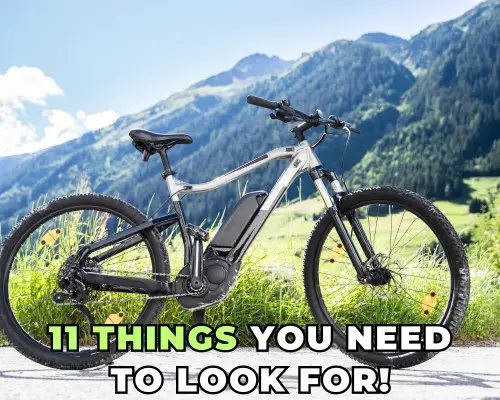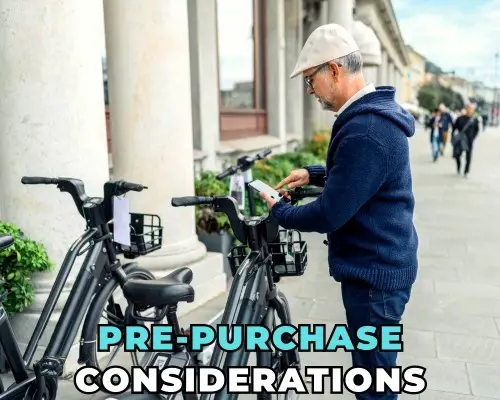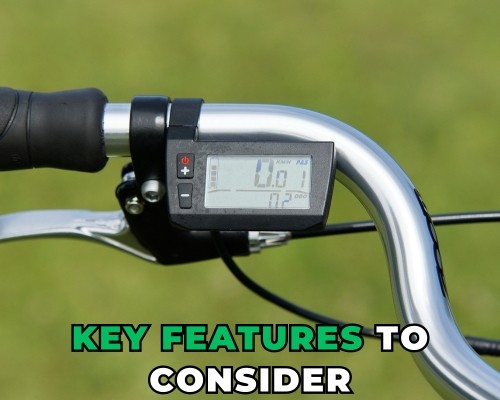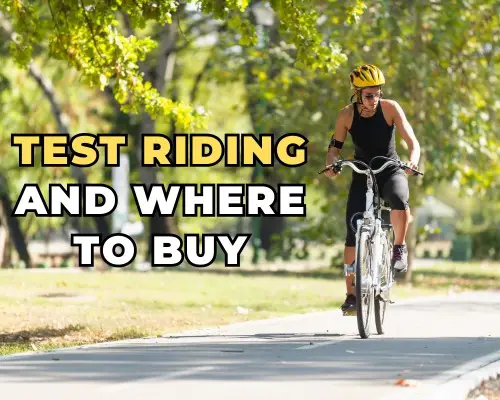Ever entered an e-bike store only to feel overwhelmed by the variety of models available? Yeah, us too. Choosing an e-bike sometimes feels like cracking a complex code.
Battery life, motor power, and unique features – each one seems more promising than the previous model. But what is it that you need in your electric ride? Certainly, that’s not just about the speed or design.
Would you get through city traffic with comfort? What about handling some rides on hills? Surely, that’s more than a couple of questions that deserve an answer. Moreover, let’s admit it, investing in a purchase that then does nothing, is a huge bummer.
Stay with us while we examine the critical aspects of your e-bike experience – that one you own according to your money.
Buying an E-Bike: 11 Things You Need to Look for!

Battery Safety
Are you in the market for an e-bike? Then look out for the battery first, and identify whether it is UL certified. It is not just a label; it is your confidence.
With your e-bike battery being UL certified, the safety standard is top-notch. Not to worry about the threat of the battery blowing off; This is because it has a safer battery leading to the best ride history you have each power.
Class of E-Bike
Decoding e-bike classes can feel like a quiz. Class 1 e-bikes offer pedal assist up to 20 mph—perfect for those leisurely bike path rides.
Class 2 models include a throttle, letting you zip up to 20 mph even when you stop pedaling, ideal for when you’re tired but still miles from home.
And Class 3? They push you up to 28 mph, great for longer commutes where speed is key. Choose based on your daily route and how much leg work you want to put in.
Motor Type
Your motor choice shapes your ride. Hub motors, often seen in budget models, keep costs down but can lag on hills.
Mid-drive motors, positioned right at the bike’s crank, distribute weight more evenly, offering a natural ride feel—like the bike is propelling itself.
Though more expensive, they excel in hilly terrain and can mean the difference between a smooth ride and a sweaty struggle.
Brakes
Strong brakes are a must. Imagine descending a steep hill when a squirrel darts out. Quality brakes that handle the extra weight of an e-bike ensure you stop safely, not a moment too soon.
Hydraulic brakes, though pricier, provide more stopping power with less effort—worth considering if your routes involve tricky descents.
Tires
Tires link you to the path. Rough terrains demand knobby, durable tires; they grip dirt and mud like a pro.
Urban riders should look for thicker, puncture-resistant tires that can shrug off city debris. Remember, the wrong tire on the wrong terrain doesn’t just feel off—it can be dangerous.
Suspension
Don’t cut corners on the suspension if your trails are more uneven than a popcorn ceiling. It’s about control more than it is about comfort.
For safer, more predictable handling, a solid suspension system maintains your tires in contact with the ground. Potholes won’t need to be avoided; they’ll only add to the excitement.
Frame Material
Aluminum frames strike a balance between durability and cost—a solid choice for most riders. Steel, though heavier, has a forgiving ride feel, absorbing road vibrations.
Carbon fiber? It’s the featherweight champion, stiff and strong but typically seen in higher-end models. Your choice should reflect your ride style and budget.
Weight Capacity
How much can your e-bike handle? Check the specs. It’s not just about your weight, but also your backpack, groceries, and even a child’s seat.
Overburdening your e-bike affects its handling, speed, and safety. It’s like wearing a backpack that’s too heavy—it slows you down and wears you out.
Range and Charging Time
Range anxiety—it’s real. Check the battery life. If you’re commuting or planning long weekend rides, look for e-bikes with a range of at least 40 miles.
And charging time? Some bikes juice up overnight, others in just a few hours. Think about your lifestyle—do you have the time to wait, or do you need quick turnaround times?
Maintenance
Low maintenance means more time riding. In contrast to chain drives, which require frequent cleaning and oiling, belt drives are quiet, hygienic, and low maintenance.
Think about an e-bike that has an internal gear hub as well. All of it is tucked away and shielded from dust and dirt, making shifts go more smoothly and with less hassle.
Warranty and Support
A solid warranty tells you the manufacturer believes in their bike. Look for at least a two-year warranty on parts and battery. And support? It should be accessible and helpful.
Because if something goes wrong, you’ll want experts just a call or an email away. Real support means less downtime and more cycling.
Pre-Purchase Considerations

Let us outfit you with the appropriate equipment before you jump into the e-bike pool. It’s important to choose the ideal riding companion in addition to selecting the right bike.
Assessing Your Needs: How to Determine the Right E-Bike for You
Choosing the right e-bike can feel like preparing for a big trip. You need the right equipment for the journey ahead. Here’s how to pack smart:
- Riding Style and Terrain: Think about where you’ll be cruising. Smooth city paths or rugged trails? Urban environments beg for sleek, agile e-bikes, while rough terrains call for sturdy builds with strong suspension.
- Distance and Speed: Reflect on your journey’s length and your desired pace. Regular commuters should eye e-bikes with long battery life and quick assist. For the adventurous, seek out robust models that handle extended rides with ease.
- Cargo Capacity: Will you carry more than a backpack? Look for e-bikes with solid frames and extra storage. This isn’t just practical; it’s a game-changer for day-to-day utility.
- Budget: Like any significant purchase, what you spend speaks volumes. Set a smart budget, but watch for the best value. Extra dollars now might save repair costs later.
- Maintenance: Aim for hassle-free maintenance. Seek features like belt drives and internal gears to minimize fuss and maximize riding joy.
E-Bike Classes Explained: Which Class Suits Your Cycling Style?
Each e-bike class serves a distinct purpose, much like shoes for different occasions.
- Class 1: These are your loyal helpers, offering assistance up to 20 mph but only while you pedal. Ideal for those who enjoy an active ride but appreciate a little boost uphill or on long treks.
- Class 2: Need a rest from pedaling? Class 2 e-bikes include a throttle to help you glide along at 20 mph without effort. Perfect for casual trips or when you’re feeling less energetic.
- Class 3: For speed enthusiasts, these e-bikes assist up to 28 mph and are equipped with a speedometer. They’re tailored for long commutes and faster rides, demanding more but delivering substantial speed and performance.
Key Features to Consider

Choosing an e-bike feels a bit like adapting to a major enterprise. You need the correct hardware to guarantee your travel is smooth, productive, and agreeable.
Here’s a more profound dive into those pivotal highlights to assist you select an e-bike that feels like it was made fair for you.
Battery Life and Management
Selecting the right battery is crucial—it’s your e-bike’s lifeline, much like a reliable camp stove on a long trek in the woods:
Capacity: High-capacity batteries, measured in watt-hours (Wh), are like your backpack’s volume; the more Wh, the longer the journey you can undertake without a recharge.
For an average commute, a 500 Wh battery offers a good balance between weight and range, providing about 40-70 miles depending on usage.
Efficiency: Battery efficiency, much like the fuel efficiency in a car, measures how well the battery uses its charge. Look for a higher Wh/kg ratio for a lighter bike that still delivers powerful performance.
Battery Management System (BMS): Think of the BMS as the brain of the operation. A progressed BMS not as it were secures against cheating and overheating but moreover oversees control dispersion more effectively, dragging out your battery’s life.
Charging Time: Your lifestyle will dictate your needs here. On the off chance that you are a commuter, a battery that charges completely in 4-6 hours overnight might suffice, but for longer rides, explore for quick-charge capabilities that can beat up your battery in fair 1-2 hours.
Range: The range isn’t just about battery size; it’s also about how you ride. Riding at full power or on hilly terrain will drain the battery faster than cruising on flat surfaces. A test ride can help you gauge the range in real-world conditions.
Motor Considerations
The motor of your e-bike acts as the muscles that propel you forward, choosing between types significant:
Hub vs. Mid-Drive Motors: Hub motors, hidden in the wheel hub, are great for straightforward city riding and are generally cheaper and easier to maintain.
Mid-drive engines, found centrally close to the bike’s gears, give a more adjusted, normal riding feel, basic for off-road utilize or sloping ranges.
Control Yield: Measured in watts, control yield influences how well the bicycle can climb slopes and quicken.
A 250-watt engine is satisfactory for level landscapes, but a 500-watt engine may be essential for soak slants or heavier riders.
Torque: More torque translates to better performance from a standstill, making it crucial for city riding where you often stop and start. Look for at least 40 Nm of torque for a responsive, agile ride.
Gear Ratio: Particularly for mid-drive motors, the right gear ratio allows for efficient power use across varying terrains, similar to having the right gears on a manual car for different speeds and inclines.
Importance of Frame Material and Bike Ergonomics
The frame material and design of your e-bike affect everything from weight to comfort and how you feel after a long ride:
Frame Material: Aluminum is popular for its good balance between weight and cost, while carbon fiber, though more expensive, offers the best in weight reduction and ride smoothness—ideal for those with joint issues or long rides.
Ergonomics: Like a well-fitted shoe, your bicycle must fit your body. Movable components such as situated tallness, handlebar point, and pedal position can essentially affect consolation and riding efficiency. Take the time to induce these balanced to your correct inclinations.
Suspension: In case your trails are tough, a great suspension framework is as imperative as a durable combination of climbing boots.
It can assimilate the stuns and bumps along the way, ensuring your joints and making the ride smoother.
Weight Capacity: Overburdening your bicycle is like carrying as well much in your backpack—it can strain the framework and lead to untimely wear.
Guarantee the bicycle can bolster your weight also any adapt or foodstuffs you arrange to pull.
Test Riding and Where to Buy

Setting out on the travel of buying an e-bike is energizing, but like several great pilots, you would like to test your creativity sometime recently taking to the skies.
Here’s how to guarantee your test flight uncovers everything you wish to know, and where to discover your idealized e-bike.
How to Test Ride an E-Bike Effectively
Testing an e-bike is about more than just a quick spin around the block. It’s about feeling the bike in action and seeing how it fits into your life. Here’s how to make the most of your test ride:
Get a Feel for Comfort: Sit on the bicycle; alter the situation, get a handle on the handlebars, and put your feet on the pedals.
Does it feel like a normal expansion of yourself? Consolation is significant, as indeed the foremost minor distress can turn into a major torment on longer rides.
Evaluate the Ride Quality: As you ride, pay attention to how the motor assists your pedaling. Is it smooth and responsive? You want a system that feels intuitive, not like it’s fighting your natural riding style.
Assess Handling and Stability: Take turns at varying speeds and see how the bike handles them. If you’re planning on diverse terrains or carrying loads, stability is key. The bike should feel secure and controlled under all conditions.
Check for Noise and Vibration: Listen carefully. High-pitched whines or harsh vibrations can be dealbreakers. A good e-bike operates smoothly and quietly.
Understand Battery Life and Range: If possible, test the bike on a route that simulates your regular commute or favorite trail. This helps gauge the battery’s endurance and whether it fits your daily needs.
Test Different Modes: Experiment with different assistance levels or riding modes. Each mode should suit different parts of your riding experience, whether climbing hills or cruising flat stretches.
Experience the Interface: Interact with the bike’s controls and display. Can you easily change the settings on the move? This practicality is crucial for enjoyable rides.
Choosing the Right Store: Online vs. Local Shops
Where you buy your e-bike can be as important as the bike itself. Here’s how to decide between the digital and the tangible:
Local Bike Shops: The traditional way has its perks. Local shops offer expert advice, immediate support, and the invaluable opportunity to test-ride various models.
It’s the personal touch—the shop staff gets to know you and can help tailor suggestions based on your needs.
Online Shopping: If variety is your priority, online might be your best bet. It offers a broader range of models and often better deals.
The trade-off? You miss out on the direct support and instant gratification of riding your new bike as soon as you buy it.
Test Rides: Make sure whether online or in-store, you can test the bike. Some online retailers partner with local shops to offer test rides.
Warranty and Support: Check the fine print. A good warranty and accessible support can save you much hassle down the road. Ensure that parts and maintenance services are readily available.
Navigating Your Purchase
Choosing where to purchase your e-bike isn’t fair an exchange; it’s the starting of a relationship together with your bicycle and its back arrange.
Whether you esteem the hands-on offer assistance of a neighborhood store or the sweeping alternatives online, make beyond any doubt it’s a choice that brings consolation and certainty.
With the correct preparation and understanding, you’ll not fair purchase an e-bike—you’ll contribute in an other way to investigate your world.
As an Amazon Associate, I earn from qualifying purchases, at no additional cost to you. Read Our Affiliate Disclosure.

